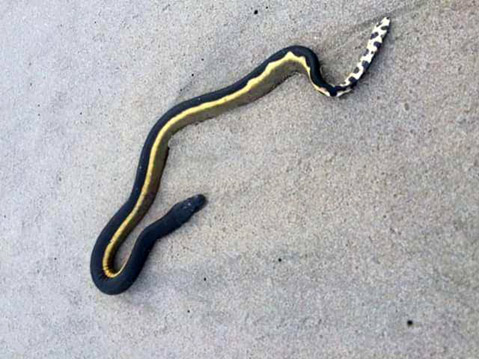Central Coast Begins to Feel El Niño’s Effects
Hail Storms and Sea Snake Sightings Back Experts’ Warm Winter Predictions

The National Oceanic and Atmospheric Association (NOAA) released an updated report Thursday on El Niño predictions for the upcoming year. Forecaster Jon Gottschalk of the Climate Prediction Center at the National Weather Service expects average sea-surface temperatures to climb more than 2 degrees Celsius, which would result in warmer weather and higher humidity through January.
His report also states that temperature hikes would be the most prominent along the Pacific coast. Within California specifically, forecasters expect above-median rainfall for the central and southern coasts. Though these warm temperatures had already been predicted, Gottschalk’s predictions expect a higher probability of these climate anomalies to actually occur.
However, according to NOAA’s deputy director Mike Halpert, there are other factors to consider. “While temperature and precipitation impacts associated with El Niño are favored, El Niño is not the only player. Cold-air outbreaks and snowstorms will likely occur at times this winter. However, the frequency, number, and intensity of these events cannot be predicted on a seasonal timescale,” said Halpert in his report statement.
Southern California residents could feel Halpert’s report only a day after its release. On Friday, Santa Barbara County experienced a string of intense thunderstorms that dropped hail the size of dimes in some areas. Multiple flash flood warnings took to the airwaves on Friday and Saturday as well, ranging from Long Beach all the way up to San Luis Obispo, and as far inland as Burbank.
Warmer ocean temperatures have not only brought new weather to Southern and Central California, but also new wildlife. PBS (Public Broadcasting Services) has reported that fishermen off the coast of San Diego are discovering Bluefin tuna, yellowtail, and dorado, which are all characteristically found further south in Mexico. Earlier this summer, San Diego and Orange County also saw phenomenal numbers of red crab corpses on their beaches following the species’ movement with the warmer waters.
The natural food chain has set up a domino effect, as these migrations of prey have also brought along their predators. According to CBS, a fisherman off the coast of Huntington Beach encountered a ten-foot hammerhead shark while fishing for yellowtail. The same beaches have also been home to sightings of great white sharks — one reportedly bumped a surfer in August.
Most recently, two sightings of a venomous sea snake species have been reported. On Thursday evening, Anna Iker reported seeing a yellow-bellied sea snake (Pelamis platura) while at the beach with her kids. Next morning another local resident, Robert Forbes, reported a separate sighting. Heal the Bay, an environmental advocacy nonprofit, confirmed both sightings were at Silver Strand Beach in Oxnard but could not confirm they were of the same animal. The group later stated in a blog post that the last sighting of a yellow-bellied sea snake this far north was in the early 1980s, also during El Niño.



